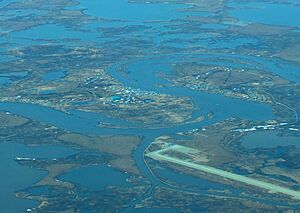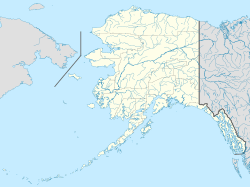Nunapitchuk, Alaska facts for kids
Quick facts for kids
Nunapitchuk
Nunapicuar
|
|
|---|---|

Aerial view of Nunapitchuk in May 2014
|
|
| Country | United States |
| State | Alaska |
| Census Area | Bethel |
| Incorporated | August 26, 1969 |
| Area | |
| • Total | 7.96 sq mi (20.61 km2) |
| • Land | 6.99 sq mi (18.11 km2) |
| • Water | 0.97 sq mi (2.50 km2) |
| Elevation | 10 ft (3 m) |
| Population
(2020)
|
|
| • Total | 594 |
| • Density | 84.98/sq mi (32.81/km2) |
| Time zone | UTC-9 (Alaska (AKST)) |
| • Summer (DST) | UTC-8 (AKDT) |
| ZIP codes |
99641
|
| Area code | 907 |
| FIPS code | 02-56680 |
| GNIS feature ID | 1407339 |
Nunapitchuk is a small city in Alaska, United States. It is located in the Bethel Census Area. The name "Nunapitchuk" comes from the Yup'ik word "Nunapicuar". In 2020, about 594 people lived there.
Contents
Where is Nunapitchuk?
Nunapitchuk is found in the Yukon-Kuskokwim Delta region of Alaska. This area is known for its swampy, flat land called tundra. The city is located at 60.896352 degrees north and 162.454383 degrees west.
Land and Water Area
The city covers a total area of about 20.61 square kilometers (7.96 square miles). Most of this area, about 18.11 square kilometers (6.99 square miles), is land. The rest, about 2.50 square kilometers (0.97 square miles), is water.
Who Lives in Nunapitchuk?
The number of people living in Nunapitchuk has changed over the years. In 1940, there were 121 people. By 2010, the population grew to 496. The latest count in 2020 showed 594 residents.
Population Changes Over Time
| Historical population | |||
|---|---|---|---|
| Census | Pop. | %± | |
| 1940 | 121 | — | |
| 1950 | 125 | 3.3% | |
| 1960 | 327 | 161.6% | |
| 1990 | 378 | — | |
| 2000 | 466 | 23.3% | |
| 2010 | 496 | 6.4% | |
| 2020 | 594 | 19.8% | |
| U.S. Decennial Census | |||
Nunapitchuk first appeared on the U.S. Census in 1940. For a short time, from 1969 to 1982, Nunapitchuk and a nearby village called Kasigluk joined together to form one city named Akolmiut. However, in 1982, both communities decided to become separate cities again. Since then, Nunapitchuk has been listed on its own in every census.
Community Makeup
In 2000, there were 466 people living in Nunapitchuk. Most of the people were Native American, making up about 95% of the population. There were also some White and Asian residents.
Many households in Nunapitchuk have children. About 67% of homes had children under 18 living there. The average household had about 4 to 5 people. The median age of people in the city was 23 years old.
Life in Nunapitchuk
Nunapitchuk is unique because it doesn't have roads. Instead, buildings are connected by boardwalks. People travel to and from the village by small airplanes, boats, or hovercrafts, depending on the weather.
Local Resources
The village has one general store that sells groceries and fuel. This store is owned by a local company called Nunapitchuk, Limited. Many people in the community also get their food by subsistence fishing and hunting, which means they catch and hunt animals for their own use.
Flooding Challenges
The city often experiences flooding. In May 2020, there was a very big flood that caused a lot of damage to the area.
Education in Nunapitchuk
Students in Nunapitchuk attend the Anna Tobeluk Memorial School. This school is part of the Lower Kuskokwim School District. It teaches students from kindergarten all the way through 12th grade. In 2018, the school had 203 students and 15 teachers. English is the main language used for teaching at the school.
See also
 In Spanish: Nunapitchuk para niños
In Spanish: Nunapitchuk para niños


